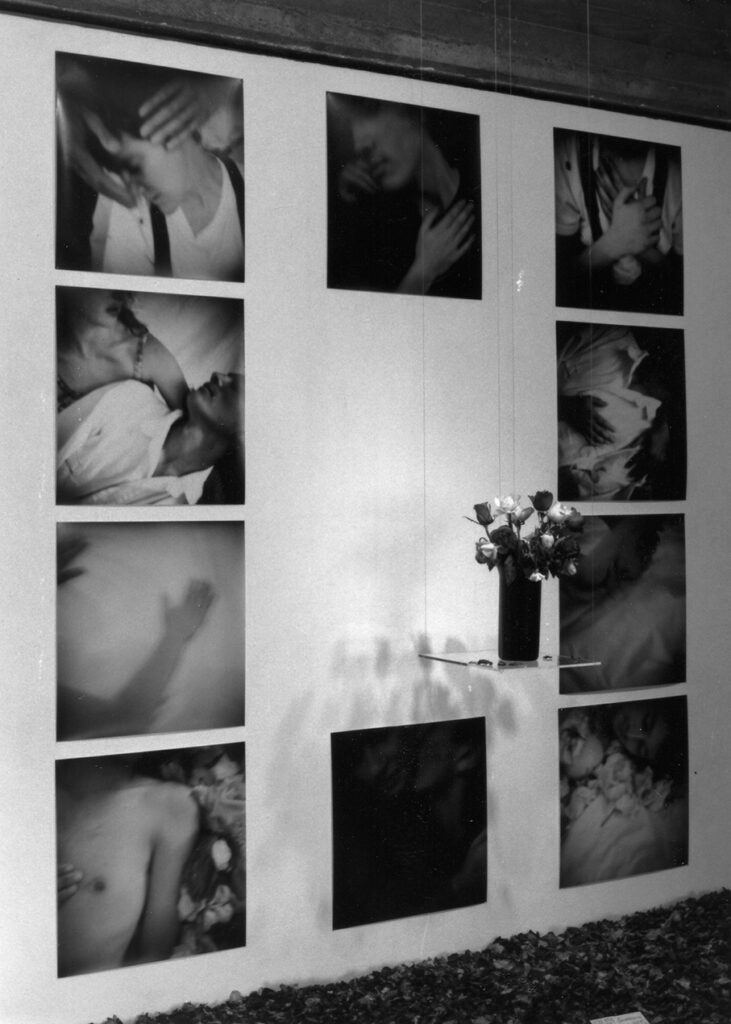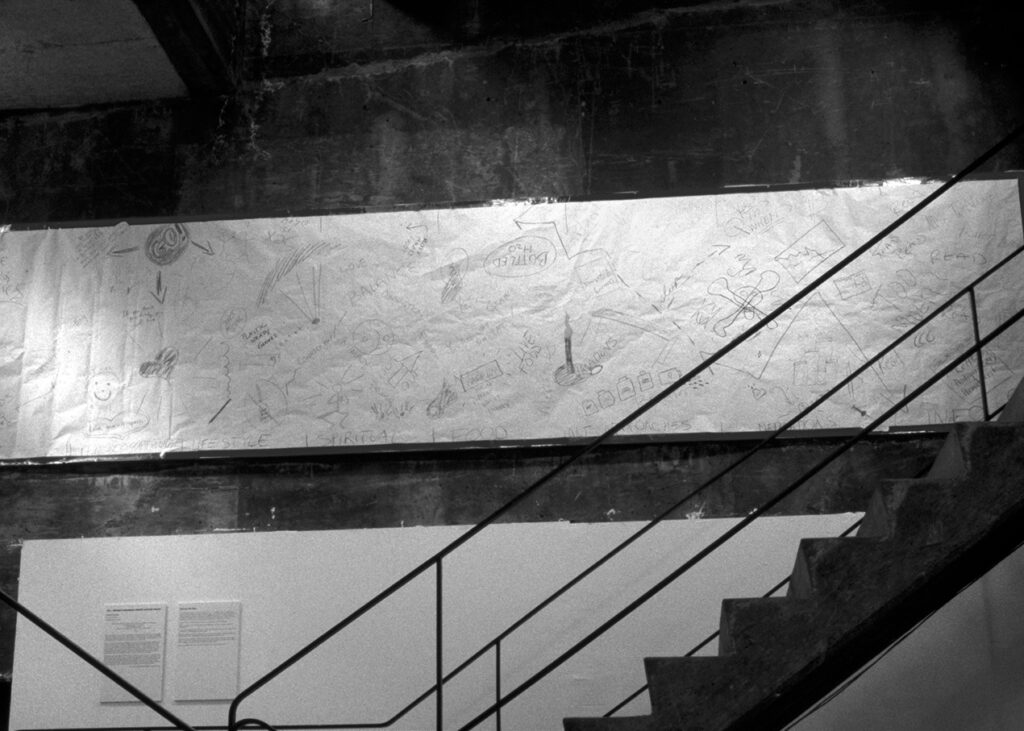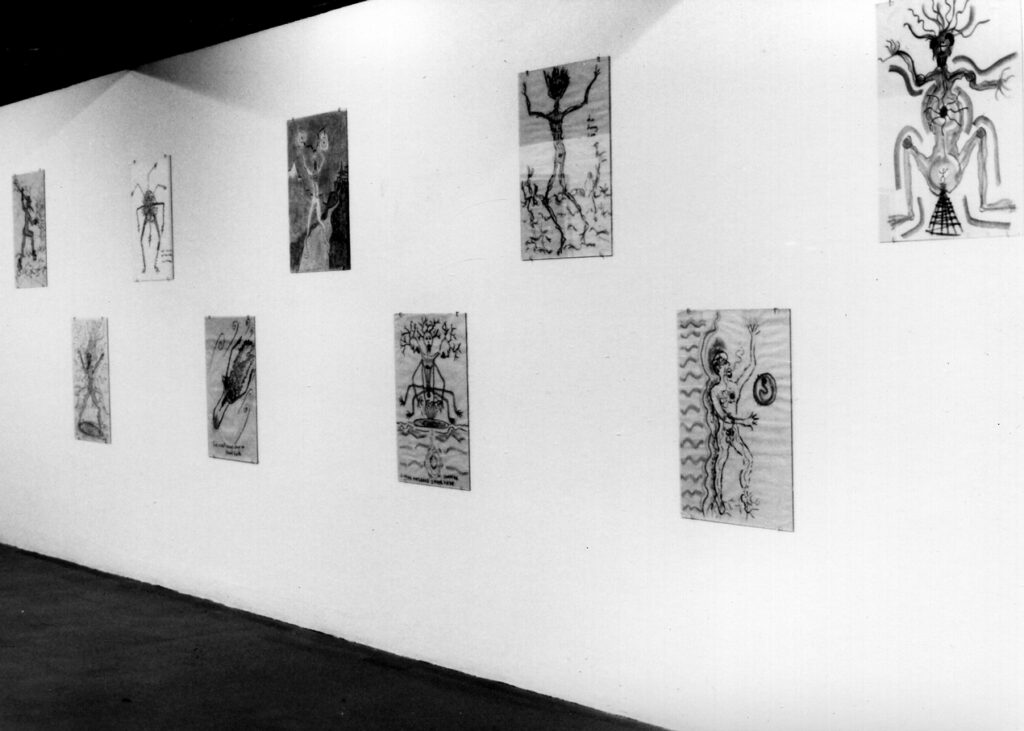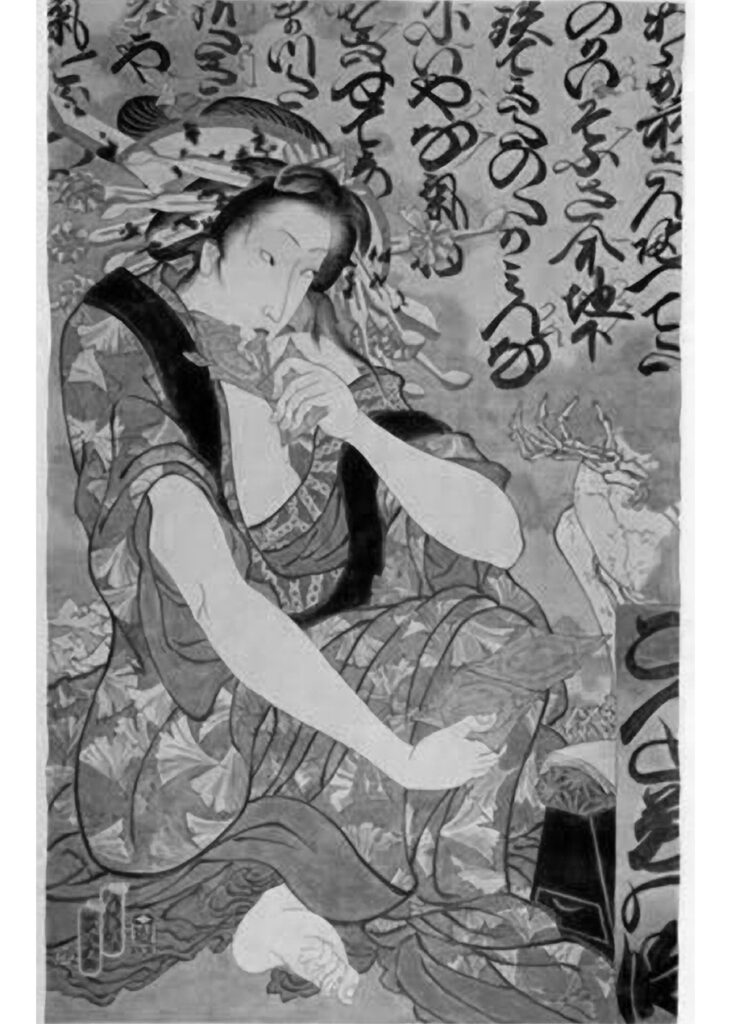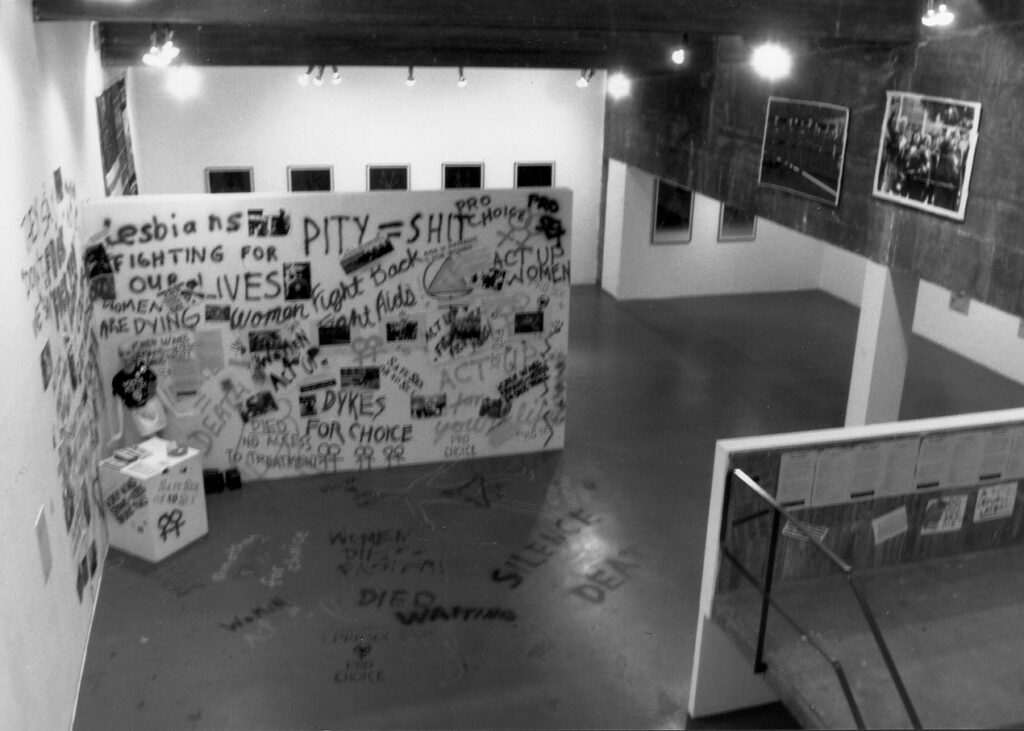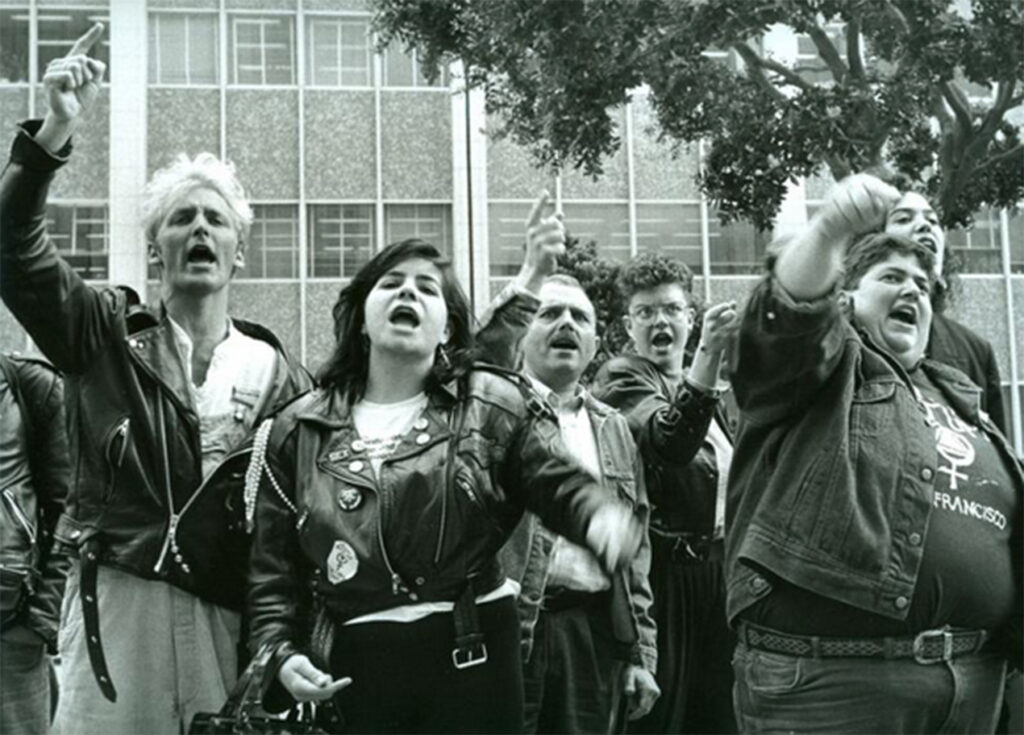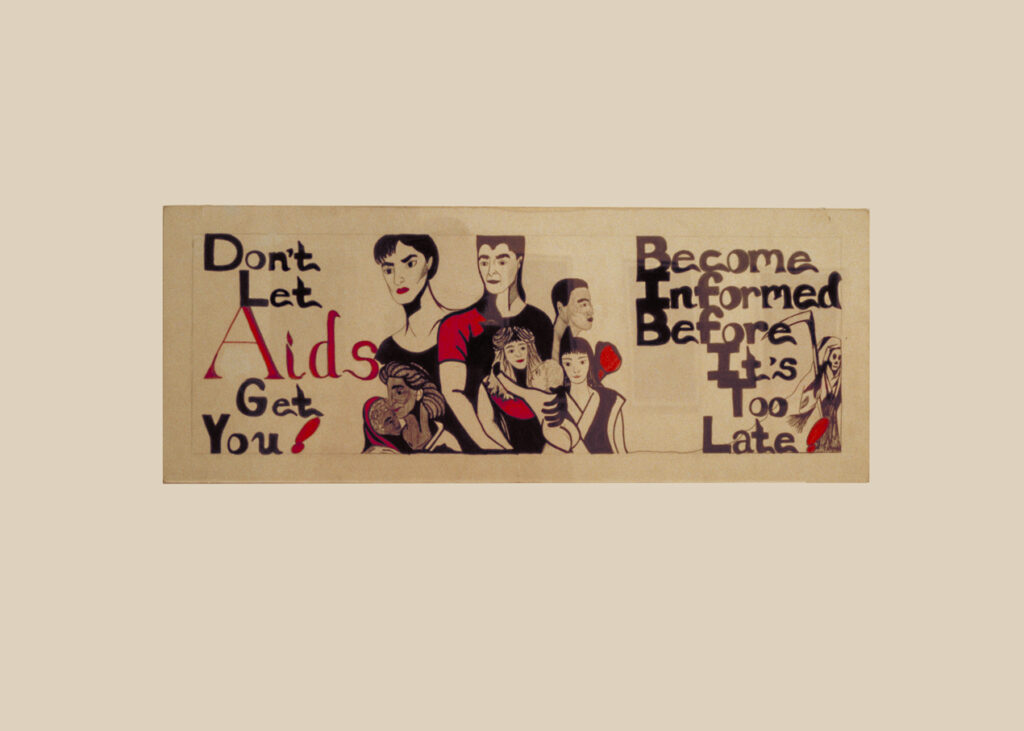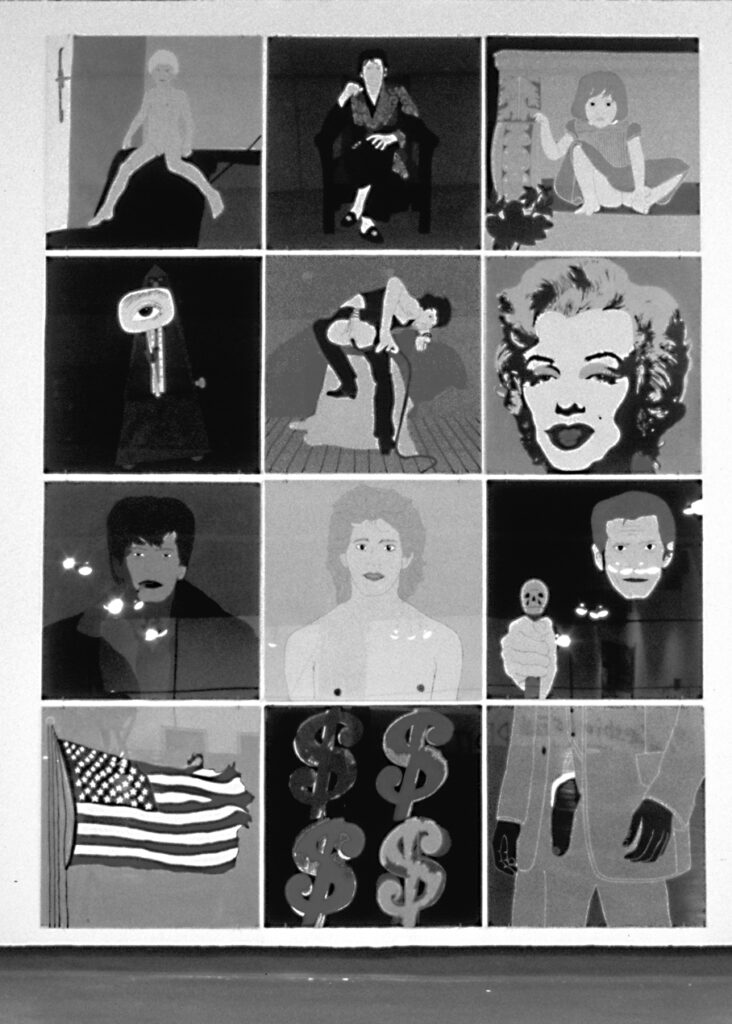Inside Out: Voices from Home

Inside Out: Voices from Home
Curated by Rudy Lemcke
San Francisco Art Institute
San Francisco, California
May 31 – July 7, 1990
The artists included in Inside Out:Voices from Home were selected for their commitment to ending the AIDS epidemic, willingness to face personal trauma with hope and support, and determination to keep AIDS-related issues in the public eye.
Ed Aulerich-Sugai’s paintings are strongly influenced by his Asian heritage. Through images of strength and power, he articulates personal issues of living with AIDS. Aulerich-Sugai states, “The helmets I paint are visual mantras, images of ferocity and longevity. They are images I focus on to bring forth the warrior in me during the times I am afraid.”
Kathryn Clark’s interactive installations focus on the emotional and physical responses to loss. Her installation for Inside Out re-sensitizes viewers to their sense of touch and investigates the lack of touching experienced by people with AIDS. Clark’s other recent projects include Mindful Affection, shown during April 1990 at San Francisco Camerawork, and A Window on AIDS, a collaborative community project in Santa Barbara.
Jane Philomen Cleland is a photo journalist whose work powerfully documents AIDS activism in the Bay Area, as well as the demonstrations of the Women’s Caucus of ACT UP San Francisco. She is staff photographer for two leading Bay Area gay newspapers.
Peter Edlund deals with the personal, psychological trauma of AIDS and the consequential emotional distancing and displacement of sexuality. In describing his own art, Edlund writes, “Image: shirt made of the skin of a man. The inside collar reads, ‘Faggot Brand’ — gloved hands hold the ‘shirt’ by fingertips. The text reads, ‘Flayed before the crowd’ … Corresponding to the tenth Station of the Cross, Jesus is stripped before the crowd. Image: the condescension and disgust over those who are gay and have AIDS. The gloves barely hold the shirt. The gloves are like those worn by the police.”
HIV+ Women’s Movement Theatre Support Group uses movement, visualization techniques and art as therapy for women affected by AIDS. They encourage participants to express their fears and anxieties about the disease through art. For the exhibition at SFAI this support organization will display drawings and paintings that are by-products of the group process.
Rudy Lemcke, guest curator for Inside Out, works in a variety of media and has used his art to make strong statements about AIDS issues. His recent projects include participation in Group Material’s AIDS Timeline at University Art Museum, Berkeley, 1989, Silent Knights at Artists’ Television Access last December and ACT UP Banners at Southern Exposure Gallery in San Francisco. At SFAI, Lemcke presents, Who Killed Robert Mapplethorpe? (1990), a multi-panel collage and painting installation on censorship.
The Names Project represents a grass-roots response to the AIDS crisis. Founded in San Francisco in 1987 by Cleve Jones, this organization continues to expand its quilt of thousands of hand-embellished, 3’x 6’ panels: individual tributes created by the families and friends of those who have died of AIDS. Their work remains one of the most poignant pieces of American political art. The AIDS Memorial Quilt has been displayed at Capitol Mall and the White House Ellipse in Washington, DC, and at cities throughout the U.S. and Canada. For Inside/Out, The Names Project presents a 12’ x 12” panel from the quilt.
Masami Teraoka’s paintings and etchings, executed in the manner of traditional Japanese art, deal with contemporary issues. Inside/Out is the premier exhibition of Teraoka’s monumental Tale of One Thousand Condoms, measuring 82’ x 133’. Also included are six lift-ground chine collé etchings of the subject of AIDS, created in the style of traditional Japanese pillow-box illustrations. This work represents the trans-cultural impact of AIDS and reintroduces the erotic during a time of sensual denial.
Women’s Caucus of ACT UP San Francisco organizes and facilitates women’s political response to AIDS, broadening the understanding of the medical and social impact of the disease on the larger community. Their display at SFAI includes photographs of civil disobedience and demonstrations, as well as information tables. They have stated, “Women (especially sex workers) are often viewed as ‘carriers’ giving HIV to men and their babies, not as people with AIDS who need care and treatment themselves.”
Youth AIDS Art Project is a consortium of youth service agencies organized by the Youth Guidance Center Preventive Education Program; The Mid-City Consortium to Combat AIDS; and Huckleberry House, San Francisco. Through art and education, this organization works to prevent an AIDS epidemic in the Francisco’s adolescent population. At SFAI, they present selections from the art competition Spread the Word, NOT the Disease: a group of 50 AIDS education billboard proposals created by local youths in San Francisco’s Mission District. These proposals have been previously exhibited at the Mission Cultural Center.
THE TAMALPA INSTITUTE
Anna Halprin, founder of the Tamalpa Institute, is a major national figure in contemporary, experimental dance. She has also pioneered the development of dance and movement techniques to aid the physical and emotional healing of non-dancers affected by AIDS. For Inside Out, Halprin presents a videotape of her work with HIV-infected people, demonstrating her techniques of ritual, visualization, drawing, and movement.
Nikko Marott is a recent graduate of the Tamalpa Institute training program. Along with Anna Halprin, he has created movement and dance workshops and is currently a member of the Positive Motion theater group. Using techniques developed at Tamalpa, Marott continues to work privately, counseling children and other individuals. His display at SFAI includes visualization drawings and a self-portrait.
Allan Stinson, a dancer, performer, artist, writer, and instructor at the Tamalpa Institute will present drawings and paintings he created during visualization workshops. Stinson recently completed choreographing and performing a dance presentation about AIDS for the Isadora Duncan Dance Awards at San Francisco’s Herbst Theater and, with Anna Halprin, is co-authoring Circle the Earth: A Search for Living Myths and Rituals through Dance.
AIDS is not only a biological event but also as cultural phenomenon. Its forms of representation are as diverse as the communities it affects. This show offers an array of artistic responses to this crisis that reflect the many VOICES from HOME.
Rudy Lemcke 1990
More About the Artists
Ed Aulerich-Sugai is an Asian American Artist who lives and works in San Francisco. His work is strongly influenced by his Asian heritage. In INSIDE OUT Aulerich-Sugai exhibits seven of his chalk and water-based media paintings from his series based on Samurai helmets. He has taken the symbolism and potency of these traditional images and infused them with a personal iconography and structure of meaning.
Aulerich-Sugai has created a deeply personal representational system in these paintings. He states, “Since the beginning of my illness, fear has overpowered me many times. Then, I look into my Japanese ancestry and call forth the warrior there. The Samurai Helmets portray that warrior. Like the totem poles of the Pacific Northwest Indians, the helmet decorations depict the powers specific to a family clan or warrior. I use them as visual mantras, empowering me with their certain strengths – the ferocity of a deep sea eel, the longevity of giant oak leaves.” These paintings portray “the will to survive. They are meditations that help me focus on my inner strengths. They function as healing images.”
Ed Aulerich-Sugai received his BFA in Painting from the San Francisco Art Institute in 1974. He has exhibited his work in San Francisco, Los Angeles, West Virginia, and Seattle. His work appears in a recently published work of images and words by people with AIDS titled 100 Legends. In 1989 he was invited by San Francisco Artists Against AIDS to participate in “Talking about Living with AIDS: PWA’s talk with Spalding Gray.”
Kathryn Clark has recreated an installation titled “Rose Window” for INSIDE OUT This installation was originally displayed as part of the 1989 city-wide “A Window on AIDS” project in Santa Barbara for which she played a central role as project coordinator. “A Window on AIDS” included fourteen window installations throughout Santa Barbara that represented collaborative and individual efforts by a coalition of over 30 local artists. The artists involved met regularly to educate themselves about the issues surrounding the AIDS crisis. Their windows offered images illustrating personal and cultural responses to the epidemic.
Clark’s “rose widow” consists of a series of photographs taken with a thrift-store-bought Diana camera. Her soft, dream-like images are those of gesture, touch and intimacy. On the ground beneath the photographs is a bed of dried rose petals that symbolize the deaths to AIDS. We are asked to look into Clark’s window on AIDS.
Kathryn Clark resides in Santa Barbara, California. She has received numerous grants and awards for her work and has exhibited nationally. She has recently exhibited a body of work titled “mindful affection” at San Francisco Camerawork.
Peter Edlund deals with the personal, psychological trauma of AIDS in the gay community and the consequential emotional distancing and displacement of sexuality. The works exhibitied in INSIDE OUT were chosen from fourteen pieces that were installed at Intersection for the Arts in January of 1989. The installation was titled “Questionable Blessings” and was thematically related to the stations of the Cross.
Although one might assume that the work takes on certain aspects of victimization in using the imagery of the Passion of Christ in this work, Edlund is in fact using this work as a personal “exorcism, a cleansing and healing from the bigotry, isolation and shame we live with in an age when ‘gay means AIDS.” His paintings speak about; “the resignation one feels in light of popular reaction and government inaction to the crisis; the emotional difficulties of having an intimate homosexual relationship when disease is a threat; the fear of intimate and/or casual contact; the horror of illness and death; the social “labeling” for being part of a disenfranchised group, and the internalization of these emotions.”
Peter Edlund resides in San Francisco. He has exhibited recently at New Langton Arts, Southern Exposure, Intersection for the Arts and Artists Television Access. He has been invited to participate in “Crossing Boundaries: Soviet-American Innovation and Collaboration in the Arts” this summer in Moscow.
HIV+ Women’s Movement Theatre Support Group is an ongoing bimonthly women’s support group working in the Bay Area. By using movement theater techniques the group identifies, expresses, and works through issues surrounding HIV infection. The theater is private, in that it exists only for those who participate. We can only glimpse their work from the piece that they have included in the exhibition. The artwork is a tool that is used in the verbal, visual, and physical creation of their theater.
Personal issues of isolation; intra-personal issues of support and care giving; family issues of the communication of illness to the children of mothers with HIV infection; and the stigmatization of women with AIDS are but a few of the themes of their work. The piece shows in this exhibition was created during a performance on “obstacles” that the group perceived to be central to women with HIV infection. This piece is only one aspect of the work. Although it might not be defined as beautiful by traditional Eurocentric aesthetic standards, the group and its work represent some of the most authentic, relevant, and powerful work created during the AIDS crisis. The origins of many of the group’s techniques can be found in Anna Halprin’s workshops at the Tamalpa Institute.
The Names Project was established in June of 1987 in the heart of San Francisco’s Castro district. The Quilt began as a response by lesbians and gay men and their friends to the devastation of their community by AIDS. From this beginning, the NAMES Project has sought to reach out to everyone affected by the epidemic. The NAMES Project International AIDS Memorial Quilt serves a unique role in the battle against AIDS. By organizing and displaying the Quilt, the NAMES Project strives to: 1) Confront individuals and governments need for an immediate and compassionate response, by revealing the names and the lives behind the global statistics. 2) Build a powerful, positive, creative symbol of remembrance and hope, linking diverse people worldwide in response to AIDS. 3) Encourage donations in every community where the Quilt is displayed, thereby raising the desperately needed funds for people living with AIDS and their caregivers.
The NAMES Project displays one of its twelve-by-twelve-foot panels from the Quilt in INSIDE OUT. The Names Project eloquently reflects the theme of this exhibition: From the intimate and personal experience of AIDS, one of the most dramatic and monumental pieces of American political art has been constructed.
Anna Halprin, Artistic Director and co-founder of the Tamalpa Institute, is a major national figure in contemporary experimental dance. She has also pioneered the development of dance and movement techniques to aid the physical and emotional healing of non-dancers affected by AIDS.
In INSIDE OUT Halprin presents videotapes of her visualization and performance work with HIV-infected people and those affected by the disease. The participants, in Halprin’s words, “have chosen to be actively and creatively involved in their own survival, and in the process learn to live life fully, now…The dances…are not necessarily pretty. They are not rehearsed and the participants are not trained dancers.” The dances are created by the participants out of real-life situations. Their performances are motivated by a powerful act of commitment to live, and in this, resides their authenticity, bravery and nobility.
Nikko Marott is a recent graduate of the Tamalpa Institue training program. Along with Anna Halprin, he has created movement and dance workshops and is currently a member of the Positive Motion theater group. Using techniques developed at Tamalpa, Marott continues to work privately, counseling children and other individuals.
The exhibition includes drawings and visualizations which Marott has used as tools in the process of creating his “life’s work.” These show several stages in the realization of images of disintegration and re-integration of the body and of the psyche. They range from the quick gesture to fleshed-out representations more like paintings. In notes accompanying his work he explains. “The drawings you see were selected from hundreds done during two years of work with Anna Halprin. They were generated through a process called psycho-kinetic visualization. These images are drawn and used as source material for further exploration by means of gestalt work, writing, movement, and partner or group sharing. Throughout the seasons, in the studio and in the natural environment, threads of my personal mythology were found and followed.” Marott lives in San Francisco.
Allan Stinson. The work of both Nikko Marott and Allan Stinson shows the persistence and expressive artistic vitality of what Carl Jung and others have referred to as archetypal images—images held in common in the human subconscious. Stinson is a dander, performer, artist, writer, and instructor at the Tamalpa Institute. Here he shows drawings created during visualization workshops. Stinson recently completed choreographing and performing a dance presentation about AIDS for the Isadora Dance Awards at San Francisco’s Herbst Theatre and, with Anna Halprin, is co-authoring Circle the Earth: Search for Living Myths and Rituals through Dance. Stinson lives in San Francisco.
Stinson’s figures, many of which are recognizable self-portraits, have the compact energy of furious concentration and of dancers poised for movement. They are marks of psychic history distilled into emblems on the page. He remarks, “I am much more at peace, and much healthier, when I listen chiefly to my own body’s signals. The real source of my strength and healing is within…I think that when some of my friends got sick, the fear and desperation took them a long way out of their bodies in search of a cure. So much of their hope was invested in external possibilities that they almost abandoned their bodies as if they could flee what was happening inside. Working with movement and visualization is important to me because it helps me turn around, go back down and deep within myself to face, to feel and to own my experience…[Healing is] about living and feeling fully the whole spectrum from joy to sadness (however long that is) and dying with a sense of peace (whenever that comes).”
Masami Teraoka is an internationally recognized Asian American artist who resides in Hawaii. With hismixture of traditional Japanese Ukiyo-e style and that of American Pop, he presents biting contemporary commentaries that address issues such as commercial excess, pollution, and AIDS. An exhibition of his work organized for the Contemporary Museum in Honolulu is currently touring the United States. Titled, Waves and Plagues, this exhibition features many of Teraoka’s paintings on the theme of AIDS.
One of these paintings, “Tale of a Thousand Condoms: Geisha and Skeleton (1998), eleven feet high, is featured in the exhbition. Like the work of Ed Aulerich-Sugai, Teraoka’s work reflects a trans-cultural event in the visusual language of a specific population. In the work of Teraoka, the issues of AIDS are assimilated into the myth structure of Japanese tradition and then reintroduced to the West. By holding a two-way mirror to work such as Teraoka’s, we can reflect on the assimilation of AIDS into our Western visual tradition.
Teraoka is also represented in this exhibition by five small lift-ground chine colle etchings done in the style of traditional Japanese pillow-book illustrations. These pictures reintroduce the sensual and the erotic into art in a time of sensual denial brought about by fear.
The Women’s Caucus of ACT UP San Francisco. Through education, direct action and civil disobedience, ACT UP has changed the course of the epidemic. It will most certainly be credited for helping to bring about the end of AIDS. The Women’s Caucus of ACT UP San Francisco was formed to educate, empower, and mobilize the women’s membership witiiin ACT UP. In order to communicate the specific issues of women with HIV infection and those affected by the disease, the group provides a forum for discussion, provides, education to the community and creates an agenda of women’s issues to be discussed by the general membership. Issues such as the exclusion of women from many AIDS drug trials; the rapid spread of the disease in women of color, low income, homeless and single women; the transmission of HIV to women through IV use; the stigmatization for women as carriers of disease—particularly prostitues; and the constant fight for visibility of women are among the issues of priority for the Women’s Caucus. In a health care system that is experiencing an explosion of female HIV infections, the role of the Women’s Caucus has become crucial to the development of ACT UP.
Jane Philomen Cleland is a bay area photographer and a member of the Women’s Caucus of ACT UP San Francisco. By documenting the actions of ACT UP with particular focus on the Women’s Caucus, she has helped to balance the public perception of ACT UP and bring to the forefront the contribution of the women’s community in the battle against AIDS.
Youth AIDS Art Project is a consortium of youth service agencies organized by the Youth Guidance Center Preventive Education Program, the Mid-City Consortium to Combat AIDS, and Huckleberry House, San Francisco. Through art and education, this organization works to prevent an AIDS epidemic insane Francisco’s adolescent population. Presented here is a selection from the art competition “Spread the Word, NOT the Disease,” a group of AIDS education billboard proposals created by local youths in San Francisco’s Mission district.
Youth AIDS Art Project (YAAP) brought together thirteen local agencies to collaborate on this project. Each agency held its “local” competition, making it as relevant to its populations’ needs as possible, organizing educational sessions, showing videos and fostering discussion. After this educational session, interested youth were asked to enter the art competition, addressing one of the following tow ideas: 1) We all know by now that AIDS is a disease that can be prevented…With the above information in mind, show how you and other teens can prevent the spread of AIDS. This may include a connection with sex, drugs, using condoms, or whatever makes sense to you. 2) AIDS is a scary thing to think about. It can mean thinking about how you take care of yourself to figure out if you are at risk for being infected with the AIDS virus. It may also mean thinking about illness or death, and bring up feelings of sadness or anger.”
Two hundred and thirty-nine youths participated in the educational sessions, and one hundred and five competed an art poster for agency-level judges. From the thirty-nine finalists, five winners were chosen in January 1989 by a panel which included youth representatives, artists and educators. During March of 1989 the prize-winning billboards were displayed at several San Francisco locations.
Eleven of the finalists’ proposals are displayed in this exhibition. These works resonate with the multivalent issues sex, drugs, and AIDS education present to adolescents at risk for contracting the HIV virus; they also point to the complexity of educating a specific community where traditional classroom approaches have failed. Youth AIDS Art Project is attempting to bridge that gap.
Rudy Lemcke , who is also the guest curator of the exhibition, is a San Francisco artist who has created several bodies of work on the issues surrounding AIDS. He brings to the creation of this exhibition his commitment to help end the AIDS epidemic through action and to keep the issues of AIDS in the public eye through the visual arts.
“Who Killed Robert Mapplethorpe?” is a twelve-part painting about the impossibility of communicating subjective experience. By reinterpreting now-familiar images created by Robert Mapplethorpe and Andy Warhol, he inserts into the exhibition the question, “At the point where the subjective becomes the object of discourse, is the original gesture lost?” The relation of the private and the subjective to the exposed or public is one of the underlying themes of INSIDE OUT, and Lemcke here deals with the forces that can change the role and intent of an artist’s work.
Lemcke has used a variety of mediums in his work, reflecting his pragmatic approach of employing “the appropriate visual strategy for a particular issue and site.” His “Garden: san Francisco AIDS Memorial” proposal for the Harvey Milk Plaza in San Francisco’s Castro district addressed the issue of the “memorial” from an historical perspective. In contrast, his ACT UP banner painting spoke of the immediacy of the issues of AIDS. “Fin Again(s) Wake,” an installation at San Francisco’s Intersection for the Arts gallery, dealt with the absurdly complex AIDS treatment and drug bureaucracy.
Lemcke’s “Clean Works” installation in the heart of San Francisco’s “crack alley” was intended as a public education message for a specific population. He has also created a private body of work for an AIDS treatment ward and worked as a board member of Community Spirit Art Program to promote well being among artists who have been affected by AIDS. He recently participated in Group Material’s “AIDS Timeline” at the University Art Museum in Berkeley.

